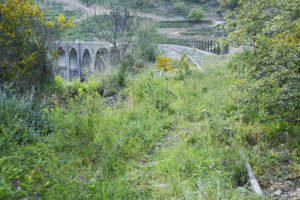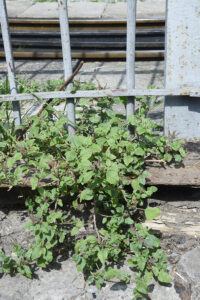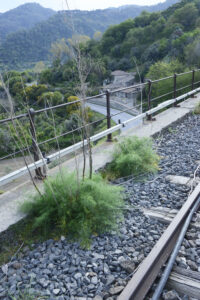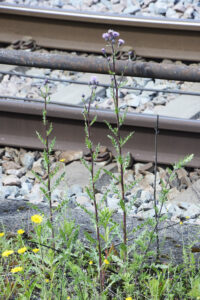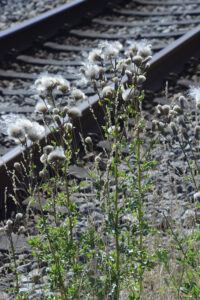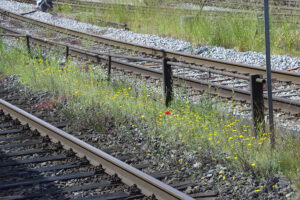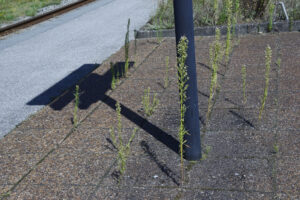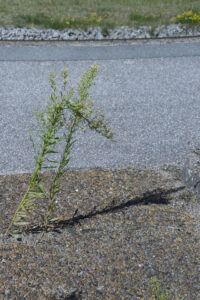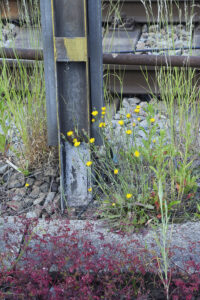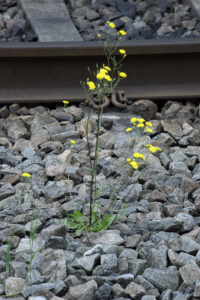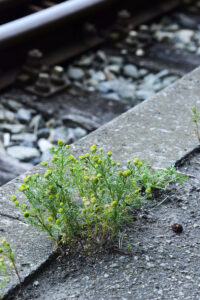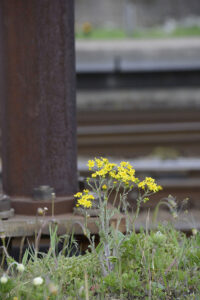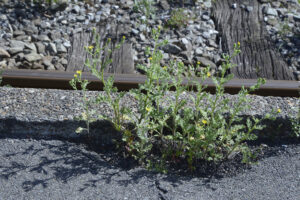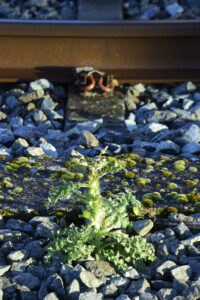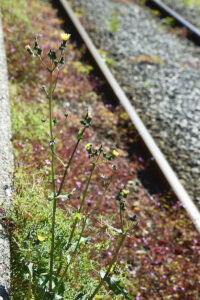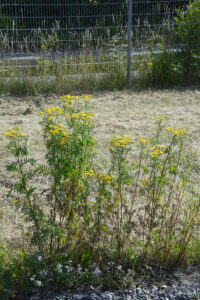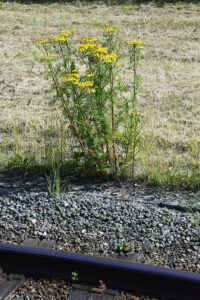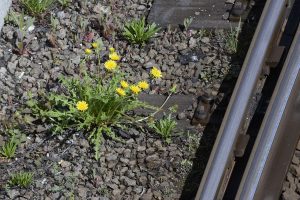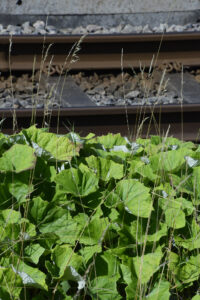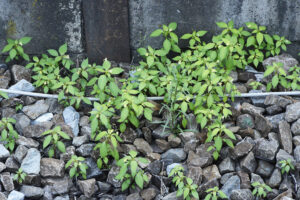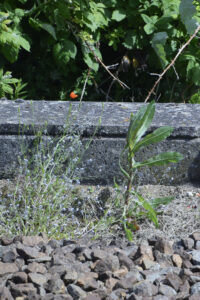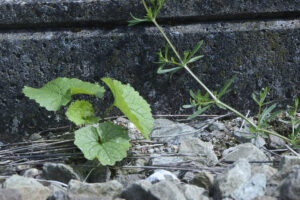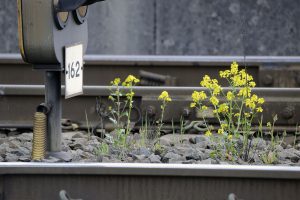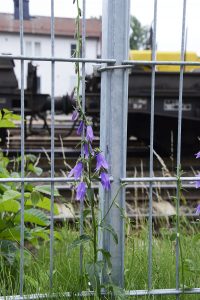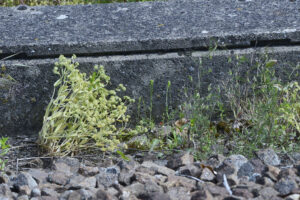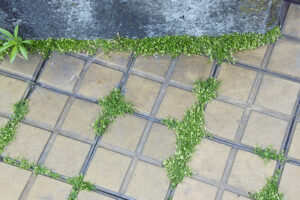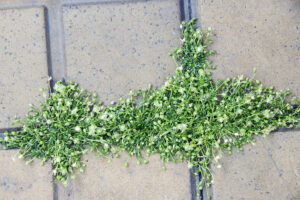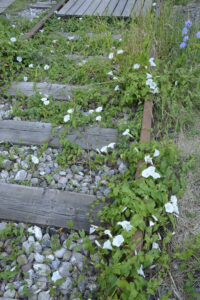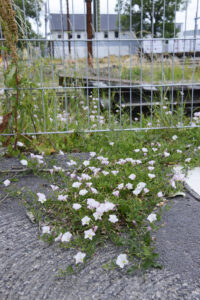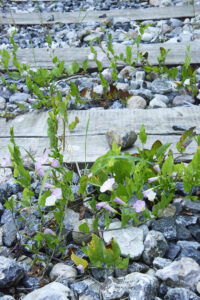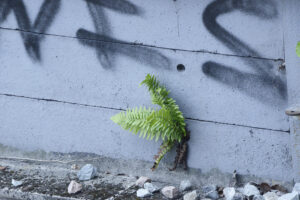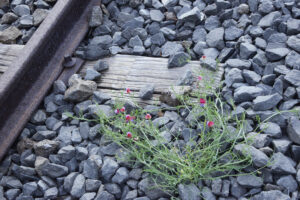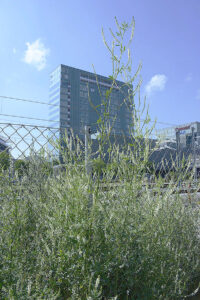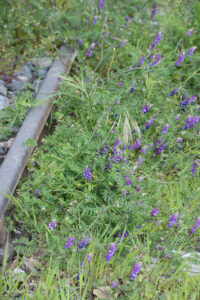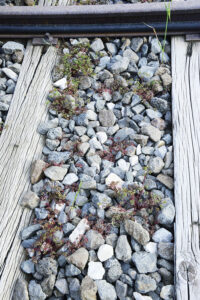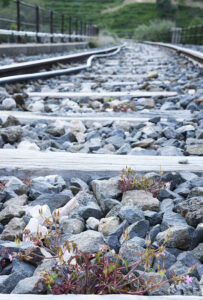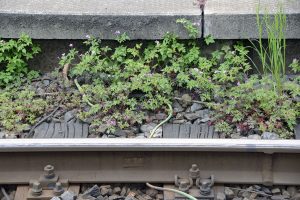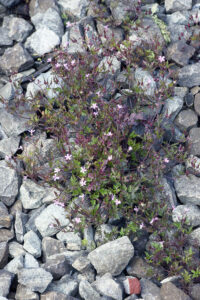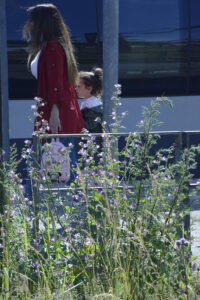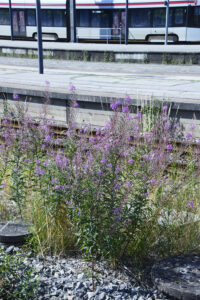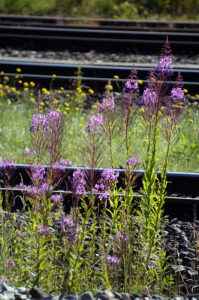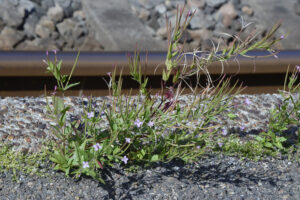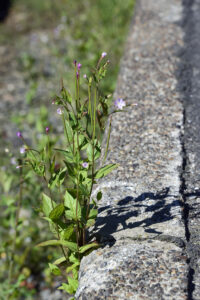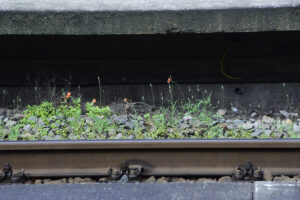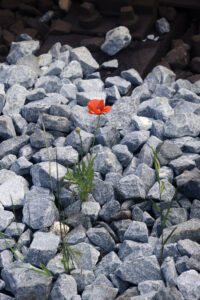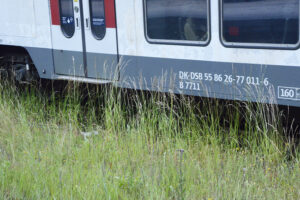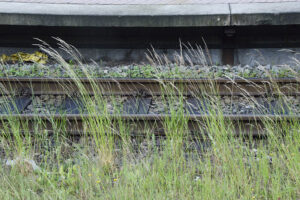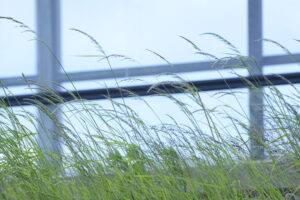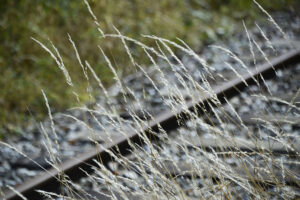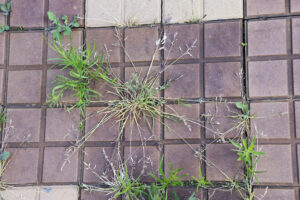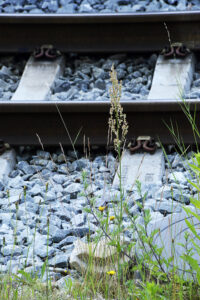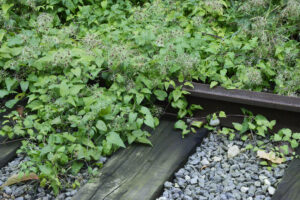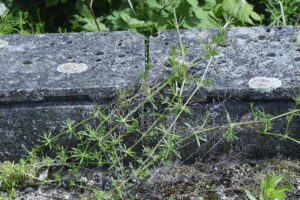Railway flora
Vegetation has conquered this abandoned railway near the small town of San Cataldo, Sicily. (Photo copyright © by Kaj Halberg)
Vegetation has invaded this abandoned railway tracks in Nyborg, Denmark, including false oat-grass (Arrhenatherum elatius), red fescue (Festuca rubra), wild chervil (Anthriscus sylvestris), common mugwort (Artemisia vulgaris), dovesfoot crane’s-bill (Geranium molle), common goat’s-beard (Tragopogon pratensis), dandelion (Taraxacum officinale), narrow-leaved plantain (Plantago lanceolata), a species of burdock (Arctium), white clover (Trifolium repens), and traveller’s joy (Clematis vitalba). (Foto copyright © by Kaj Halberg)
Many plants have adapted to a life along railways, which often constitute a refuge – at least until the worker arrives with chemical herbicides or a mower.
Abandoned railroad tracks, overgrown by mosses, ferns, and other plants, Jiancing Historic Trail, Taiwan. (Photo copyright © by Kaj Halberg)
Originally, the Jiancing Line Lumber Transportation Track, eastern Taiwan, was about 5.5 km long. As its name implies, it was constructed to bring out timber from the Taipingshan Mountains, part of which today constitutes the Taipingshan National Forest Recreation Area.
Jiancing Historic Trail was established along remains of this old railroad track. Besides the tracks themselves, you may study skids, switches, trolley axles, and deserted workers’ dwellings.
Jiancing means ‘seeing the sun’. The name was possibly given due to the fact that this area is often enveloped in fog, and finally seeing the sun breaking through the fog might be relieving.
Amaranthaceae Amaranth family
Amaranthus viridis Slender amaranth
The native area of this species, also known as green amaranth, is unknown, and today it is distributed in all warmer areas of the world. Leaves, as well as seeds, are eaten in many parts of the world, and in India it is utilized in traditional Ayurvedic medicine.
Prostrate form of slender amaranth, growing at a fence, Long Bien Railway Station, Hanoi, Vietnam. (Photo copyright © by Kaj Halberg)
Apiaceae Umbellifers
Ferula communis Giant fennel
There are two types of this huge plant, one poisonous to livestock, and one non-toxic. Young stems and inflorescences were eaten in Ancient Rome, and they are still a source of food in Morocco. It is found in the Mediterranean region, in Arabia, and in eastern Africa, southwards to Tanzania.
Pictures, depicting flowering specimens of this impressive plant, are shown on the page In praise of the colour yellow.
Giant fennel, growing along an abandoned railway, San Cataldo, Sicily. (Photo copyright © by Kaj Halberg)
Asteraceae Daisy family
Artemisia vulgaris Common mugwort
This plant is native to the major part of Temperate Europe and Asia, and also to North Africa and Alaska. In other areas of North America, it has become naturalized. Originally, it was restricted to dry grasslands and sandy beaches, but when farming was introduced, it readily spread to fields, and today it is regarded as a noxious weed.
In China, this species is sometimes used as a substitute for A. argyii to make moxa, which is much utilized as a healer in traditional Chinese medicine.
Common mugwort, Skanderborg Railway Station, Denmark. (Photo copyright © by Kaj Halberg)
Cirsium arvense Creeping thistle, Canada thistle
This proliferous spiny herb is found in most temperate areas of Asia and Europe, and has also been accidentally spread elsewhere around the globe. It is a most troublesome weed in most cooler parts of the world. As far back as 1863, Danish research showed that a large creeping thistle can produce about 80 flowerheads in one season, and as flowerheads on average contain 120 flowers, one single plant is able to produce about 10,000 seeds per year! The invasiveness of this plant is described on the page Nature: Invasive species.
It may be separated from other thistles by the rather small purplish, violet, or pink (rarely white) flowerheads, 1-2 cm across. The specific name is Latin, meaning ‘growing in fields’.
Creeping thiste and dyer’s chamomile (Cota tinctoria), Copenhagen Central Station, Denmark. (Photo copyright © by Kaj Halberg)
Creeping thiste in the fruiting stage, Aarhus Railway Station, Denmark. (Photo copyright © by Kaj Halberg)
Cirsium vulgare Spear thistle
This extremely spiny plant, also known as bull thistle, is widely distributed in the major part of Europe, North Africa, and western Asia, eastwards to the Yenisei River. It has also been accidentally introduced to many other places, including North America and Australia, where it is often regarded as an invasive weed.
Spear thistle is biennial. During the first year, it produces a leaf rosette, which overwinters and grows into a stem, up to 1.5 m tall, the following summer, displaying an abundance of beautiful red flowerheads. Despite its formidable armour of spines, this plant has been elected as the national flower of Scotland, hence another common name, Scottish thistle. Other lovers of the spear thistle include honey bees, bumble bees, and butterflies, which feed on the nectar, and various finches, including goldfinch (Carduelis carduelis), linnet (Linaria cannabina), and greenfinch (Chloris chloris), which greatly appreciate the seeds.
Spear thistle, Ringsted Railway Station, Zealand, Denmark. Horsetail fleabane (Erigeron canadensis) is seen in the background. (Photo copyright © by Kaj Halberg)
Cota tinctoria Dyer’s chamomile
This species, previously called Anthemis tinctoria, resembles the well-known corn daisy (Glebionis segetum), but may immediately be identified by its pinnately cut leaves. The specific name is Latin, meaning ‘used in dyeing’, derived from tingo (‘soak in dye’).
Its native area is from England and Norway eastwards to eastern Siberia, southwards to the Mediterranean, Jordan, Iran, and Central Asia, growing on meagre soils, such as sandy fields and waste plots.
Dyer’s chamomile, Copenhagen Central Station, Denmark. In the upper picture, long-headed poppy (Papaver dubium), creeping thistle (Cirsium arvense), common mugwort (Artemisia vulgaris), and the reddish form of Herb Robert (Geranium robertianum var. rubricaule) are also present. (Photo copyright © by Kaj Halberg)
Erigeron canadensis Horsetail fleabane
This plant is also known as Canadian fleabane, and some authorities regard it as belonging to the genus Conyza. It is native to North America and parts of Central America, but has been accidentally introduced to large parts of the world. In many places it has become a serious pest, especially in Europe and Australia, but also in its native North America. It prefers to grow in undisturbed areas and is particularly troublesome in newly established plantations, where it is able to resist herbicides, growing to 3 m tall, thus depriving planted species of nutrients and sunlight.
This plant contains an oil with a turpentine-like smell, which, supposedly, should deter fleas, hence its common name. Another popular name is bloodstanch, given by herbalists, who claim that an extract from leaves and flowers arrests haemorrhages from the lungs and alimentary tract.
Horsetail fleabane, Ringsted Railway Station, Zealand (top), and Skanderborg Railway Station, Jutland, both Denmark. (Photos copyright © by Kaj Halberg)
Hypochaeris radicata Common cat’s-ear
The genus cat’s-ear (Hypochaeris) is distributed in temperate areas of Europe, Asia, Africa, and South America. The number of species is disputed, varying from about 64 to 100, depending on authority.
The generic name is probably derived from the Greek hypo (‘under’) and choeris (‘young pig’), alluding to the fact that pigs enjoy eating the root of common cat’s-ear (below). The English name refers to the leaves of this species, which are covered in rough hairs.
Common cat’s-ear is native to the major part of Europe and northern Africa, but has been introduced to many other parts of the world, including the Americas, Japan, Australia, and New Zealand. In some areas, it is considered an invasive weed. It grows in grasslands, along roads and banks, in old dunes, and in waste places.
It is a perennial herb, the forked stem sometimes growing as tall as 80 cm. The basal leaves, which form a rosette, are obovate in outline, to 20 cm long and 4 cm wide, margin wavy or lobed, sometimes pinnately divided, hairy, stem leaves absent or few, similar to the basal leaves. The terminal flowerheads are bright yellow, to 1.5 cm across.
A close relative, large cat’s-ear (H. uniflora) is described on the page Plants: Flora in the Alps and the Pyrenees.
Common cat’s-ear, growing together with the red form of Herb Robert (Geranium robertianum) and common goat’s-beard (Tragopogon pratensis) (both in front), and false oat-grass (Arrhenatherum elatius), Copenhagen Central Station, Denmark. (Photo copyright © by Kaj Halberg)
Common cat’s-ear, Nyborg Railway Station, Denmark. (Photo copyright © by Kaj Halberg)
Jacobaea vulgaris Common ragwort, tansy ragwort
This species, previously known as Senecio jacobaea, is native to the entire Europe, southwards to North Africa and Turkey, and thence eastwards to the Ural Mountains and Central Asia. It has also been introduced accidentally to many other places and is often considered a troublesome weed, mainly due to its toxicity to cattle and horses. It usually grows in dry grasslands and other open places.
Popular names of this plant include stinking willie and mare’s fart, alluding to the unpleasant smell of the leaves.
Common ragwort, Copenhagen Central Station, Denmark. The other plants are common mugwort (Artemisia vulgaris) and false oat-grass (Arrhenatherum elatius). (Photo copyright © by Kaj Halberg)
Lactuca muralis Wall lettuce
This species, by some authorities called Mycelis muralis, is native to most of Europe, north-western Africa, and West Asia, eastwards to the Caucasus, where it may be found up to an altitude of 2,300 m. It has also become naturalized in North America and New Zealand.
The main habitat of this plant is woodlands, but it may also be found in open areas, including forest clearings, city walls, stone fences, and along railroads. The specific name is derived from the Latin murus (‘wall’).
Wall lettuce, growing between railroad tracks, Horsens, Denmark. (Photo copyright © by Kaj Halberg)
Lactuca serriola Prickly lettuce
This plant is named for the row of spines along the mid-vein on the underside of the leaves, and the leaf margins also have fine spines. The leaves are very variable, from entire to deeply divided. It is a tall plant, under favourable conditions growing to 2 m tall, with a slightly fetid smell.
It is native to Europe, North Africa, and temperate areas of Asia, and has also become naturalized elsewhere, growing along beaches, roads, and railroads, and as a field weed.
One folk name of prickly lettuce is compass plant. The leaves of its main stem are aligned north-south, offering the least surface area to the midday sun, but the maximum area to the weaker light early and late in the day.
Incidentally, this plant was named twice by Swedish naturalist Carl Linnaeus (1707-1778), in 1756 as L. serriola, and in 1763 as L. scariola, derived from the Latin escarius (‘edible’). The first name is probably a misspelling, which Linnaeus then corrected in 1763. However, according to the nomenclature rules, the first published name has priority.
The name scariola was used by Englishmen at least as far back as the 1400s. According to the Oxford Dictionary, one source said: “Wylde letus hat feldman clepyn Skariole.” (“Wild lettuce have field-men (farmers) called Skariole”).
Prickly lettuce, growing at Ringsted Railway Station, Zealand, Denmark. (Photo copyright © by Kaj Halberg)
Lapsana communis Nipplewort
This plant, growing to about 1.2 m tall, is native from Europe eastwards to central Siberia, southwards to northern Africa, Iran, and Pakistan, but has become naturalized elsewhere, including North America and Australia.
It grows in forests, hedges, along roads and railroads, and in fallow fields. The young leaves are edible, cooked like spinach or eaten raw in salads.
The common name stems from the 17th century, when the word nipple was regarded as being equivalent to the word papillaris, derived from the Latin papilla (‘nipple’). In Germany, followers of the Doctrine of Signatures maintained that the plant could be used to treat cracked nipples, as its flowerheads, when young, resemble nipples.
Nipplewort, growing along abandoned railway tracks, Nyborg, Denmark. (Photo copyright © by Kaj Halberg)
Matricaria discoidea Disc mayweed
Disc mayweed is native to North America and north-eastern Asia, southwards to Hokkaido, Japan. Today, however, it has been accidentally introduced to most other areas of the world, where it is a common weed, growing in open areas. Other names of the plant include wild chamomile and pineapple weed, due to its chamomile- or pineapple-like smell, when crushed.
Disc mayweed, Nyborg Railway Station, Denmark. (Photo copyright © by Kaj Halberg)
Senecio vernalis Eastern groundsel
This species blooms early in the year. Originally, it was a native of south-eastern Europe and western Asia, but was introduced to other parts of Europe in the 1700s, presumably with imported crops. Today, it is extremely common, especially on poor soils, and is regarded as a severe pest in grass, clover, and alfalfa fields.
Eastern groundsel, Copenhagen Railway Station, Denmark. A number of other plants are also seen, including corn salad (Valerianella locusta), dandelion (Taraxacum officinale), colt’s foot (Tussilago farfara), soft brome (Bromus hordeaceus), and snowdrop anemone (Anemone sylvestris), the latter an escape from a garden, as it does not grow in the wild in Denmark. (Photo copyright © by Kaj Halberg)
Senecio viscosus Sticky groundsel
As its name implies, this plant, also called sticky ragwort or stinking groundsel, is very sticky. The following quotation gives a vivid impression of its stickiness: “Sticky groundsel has characteristic glandular hairs, which secrete a substance that is as sticky as fly paper, and by the end of summer it is quite a mess with all the dust, sand, small insects, hairs, feathers, downy seeds, its own cypselas [seeds], candy wrappers, and who knows what else that have stuck to it.” (Source: luontoportti.com/suomi/en/kukkakasvit/sticky-groundsel)
Originally, sticky groundsel was a native of southern and central Europe and western Asia. Since the 1800s, it has spread considerably, mainly along railroads, and has become naturalized in northern Europe, Canada, United States, and elsewhere.
Sticky groundsel, Aarhus Railway Station, Denmark. (Photos copyright © by Kaj Halberg)
Sonchus asper Prickly sow-thistle
A stout plant, which may grow to 1.2 m tall, but is often much lower, often with a reddish stem. The leaves are extremely variable, obovate, spatulate, or elliptic, to 13 cm long and 5 cm wide, entire or irregularly divided, base eared and strongly recurved, clasping the stem, margin heavily spiny. Flowerheads are relatively few, to 2.5 cm across, in an open terminal cluster, ray florets numerous, bright yellow, disc florets absent.
This species presumably originates from the Mediterranean region, but has become naturalized in most parts of the world. In Nepal, a paste of the plant is applied to wounds and boils. It is also collected for fodder, and tender parts are cooked as a vegetable.
The generic name is a Latinized form of sonkhos, the ancient Greek word for sow-thistles, whereas the specific name is Latin, meaning ‘rough’ or ‘coarse’, alluding to the prickly leaves. The common name refers to the fact that pigs like to eat these plants, and to the leaves, which resemble young thistle leaves.
Prickly sow-thistle, Silkeborg Railway Station, Jutland, Denmark. (Photo copyright © by Kaj Halberg)
Sonchus oleraceus Common sow-thistle
This species is probably native to Europe and western Asia, but has spread to most other areas of the world. It is regarded as an invasive plant in many countries, including Australia, where it is a serious problem in crops. It is easily identified by its slightly prickly, deeply divided leaves.
The specific name is derived from the Latin oleris (‘edible’). Young leaves can be eaten as salad or cooked like spinach.
Other pictures, depicting this species, may be seen on the page Plants: Urban plant life.
Common sow-thistle, growing along a railroad track in the city of Aarhus, Denmark. The red plants in the background are the red form of Herb Robert (Geranium robertianum), and the green plant is tufted vetch (Vicia cracca). (Photo copyright © by Kaj Halberg)
Tanacetum vulgare Tansy
This plant is widely distributed in Eurasia, from England and Spain eastwards to the Pacific, and from subarctic areas southwards to the Mediterranean, Turkey, Tibet, and Japan. In former times, it was much utilized in folk medicine, but today it is mainly used for dyeing.
The common name was adapted from Old French tanesie, which came from the Latin tanacetum, which was again adapted from Ancient Greek athanatos (‘immortal’), probably referring to its persistence.
Tansy, Aarhus Railway Station, Denmark. (Photos copyright © by Kaj Halberg)
Taraxacum officinale Dandelion
This plant is ubiquitous everywhere in Europe, also along railroad tracks, and it has been spread to many other areas of the world. It is described in detail on the page Plants: Plants in folklore and poetry.
Dandelion, Alvesta Railway Station, southern Sweden. Also seen are young plants of common sow-thistle (Sonchus oleraceus) (left of the dandelion) and prickly lettuce (Lactuca serriola) (upper left corner). (Photo copyright © by Kaj Halberg)
Tussilago farfara Colt’s-foot
Colt’s-foot is native to sub-arctic and temperate areas of Eurasia and North Africa, but is commonly naturalized many places in the Americas.
The generic name, from the Latin tussis (’to cough’), as well as the common name coughwort, refer to the usage of the leaves against cough. The names colt’s-foot and horse-hoof were given in allusion to the shape of the leaves. An old name for the plant was Filius ante patrem (‘the son before the father’), referring to the fact that the flowers appear long before the leaves.
Leaves of colt’s-foot, together with false oat-grass (Arrhenatherum elatius), Aarhus Railway Station, Denmark. (Photo copyright © by Kaj Halberg)
Balsaminaceae
Impatiens parviflora Small-flowered balsam
The original range of this plant is probably mountains of Central Asia, but it has become widely naturalized elsewhere. It is regarded as an unwanted weed in many countries, often dispelling native plants in damp and shady forests.
When cooked, the leaves are edible, and the seeds can be consumed raw or cooked. Medicinally, it has been used for treatment of warts, ringworm, and nettle stings, and also to relieve an itchy scalp.
The generic name, as well as the popular name touch-me-not, were given in allusion to the way these plants spread their seeds. As the fruit reaches maturity, a tension builds up inside the pod, causing it to ‘explode’ when touched, hereby spreading the seeds a considerable distance.
The common name balsam is in fact a misnomer. It was adopted from the garden balsam (Impatiens balsamina), which was brought to Europe by the Portuguese in the 16th Century. Originally, balsamine was a Greek name of an unidentified plant with an aromatic oil, derived from balsamon (‘balsam’), which in the Hebrew means ‘spice’ or ‘perfume’.
Small-flowered balsam, Copenhagen Railway Station, Denmark. (Photos copyright © by Kaj Halberg)
Boraginaceae Borage family
Myosotis arvensis Field forget-me-not
This plant is native to Europe and Asia, but has become naturalized elsewhere, including New Zealand and North America, where it sometimes becomes invasive. It is a most annoying weed in fields, as its seeds may retain their ability to sprout for about 30 years.
Field forget-me-not, growing at Nyborg Railway Station, Funen, Denmark. Prickly-headed poppy (Papaver argemone) and prickly lettuce (Lactuca serriola) are also present. (Photo copyright © by Kaj Halberg)
Brassicaceae Cabbage family
Alliaria petiolata Garlic mustard
This plant, a native to Eurasia and North Africa, has been spreading considerably in later years, presumably due to the increased nitrogen deposition.
Around 1860, it was introduced to United States as a spice herb, and since then it has spread to most states, and to Canada as well. Its natural enemies of the Old World, such as fungi and insects, are not present in North America, which leads to a much higher seed production. Garlic mustard has invaded numerous forests, where it is able to dominate the understorey, hereby expelling native plants. It is listed as a noxious species in at least nine states in the U.S.
Leaves of garlic mustard, growing at Nyborg Railway Station, Funen, Denmark. To the right cleavers (Galium aparine). (Photo copyright © by Kaj Halberg)
Arabidopsis arenosa Sand rock-cress
This species is a native of central Europe, from France eastwards to Latvia and Ukraine, and from south-eastern Denmark south to northern Italy and Macedonia, but has been introduced accidentally elsewhere.
In Sweden, sand rock-cress is very common, mainly spreading along railways. This picture is from Alvesta Railway Station, in the southern part of the country. (Photo copyright © by Kaj Halberg)
Barbarea vulgaris Common wintercress
Today, this yellow-flowered plant, also known as yellow rocketcress, winter rocket, or wound rocket, is very common in northern Europe, especially in disturbed places, including abandoned plots, and along roads and railways. This was not always the case, as it was introduced during the 1700s from its native areas in southern Europe, North Africa, and the Near East. It has also been introduced to many other places, including Iceland, North America, and Australia.
The generic name is adapted from a medieval name of the plant, Herba Sanctae Barbarae (’Saint Barbara’s wort’). Holy Barbara was regarded as the patron saint of artillery men and miners, and as wintercress was considered a good healer of wounds, it was named after her.
According to legend, Barbara was the daughter of a rich pagan, living in the 3rd Century. Her father kept her locked up in a tower in order to protect her from the influence of the outside world. However, she secretly became a Christian and rejected to marry the man her father presented to her.
Before going on a journey, her father ordered a private bath-house to be constructed for her near her dwelling, but during his absence, Barbara had three windows put in it, as a symbol of the Holy Trinity, instead of the two originally intended. When her father returned, she informed him that she had become a Christian. He dragged her before the prefect of the province, but, despite being cruelly tortured, she held true to her Christian faith.
At night, her prison was bathed in light, and every morning her wounds were healed. Torches that were held near her to burn her were extinguished. Finally, she was beheaded, and her father himself carried out the death sentence. As punishment, he was struck by lightning and his body consumed by flame.
Barbara was buried by a Christian, and her tomb became the site of miracles. In his book Reisebeschreibung nach Arabien und andern umliegenden Ländern (Gloyer und Oldshausen, Hamburg, 1837, in English Travels Through Arabia and Other Countries in the East, Performed by M. Niebuhr, Gale Ecco, 2018), German cartographer and mathematician Carsten Niebuhr relates that he was shown her grave in the church of the village Karmelis, near Mosul, northern Iraq, in 1766. Some nearby ruins were said to have been her father’s palace.
Common wintercress, Alvesta Railway Station, southern Sweden. A small dandelion (Taraxacum officinale) is seen to the right. (Photo copyright © by Kaj Halberg)
Campanulaceae Bellflower family
Campanula rapunculoides Creeping bellflower
A native of southern Europe and West Asia, this plant has become naturalized in North America, where it is considered an invasive weed, dispelling other plants.
It resembles several other bellflower species, but can be identified by its long, one-sided inflorescence. It grows in rather open, partly shaded areas, including forest edges, roadsides, hedgerows, and along railways, and it often occurs in gardens as a weed. The tuberous root is edible, with a taste similar to parsnip. In the past, its young leaves were eaten as salad in the Nordic countries.
Other bellflower species are presented on the pages Plants: Flora of the Alps and the Pyrenees, and In praise of the colour blue.
Creeping bellflower, growing at a fence around Alvesta Railway Station, southern Sweden. (Photo copyright © by Kaj Halberg)
Caprifoliaceae Honeysuckle family
Valerianella locusta Corn salad, lamb’s lettuce
This small annual is native to Europe, western Asia, and northern Africa, where it grows in waste areas and along railways. It is also widely cultivated as a vegetable, and is a common weed in farmland. In North America it has escaped cultivation and become naturalized in many places.
Corn salad, growing at Nyborg Railway Station, Funen, Denmark. In the upper picture, prickly-headed poppy (Papaver argemone) and hairy vetch (Vicia hirsuta) are also present. (Photos copyright © by Kaj Halberg)
Caryophyllaceae Carnation family
Cerastium fontanum Common mouse-ear chickweed
This plant, growing to about 45 cm tall, is distributed from Greenland, Iceland, and Scandinavia southwards to the Mediterranean, and it has also been introduced to the Himalaya, Japan, and almost the entire North America. It is common along trails and roads, and as a weed in gardens and fields.
The generic name is derived from the Greek keras (‘horn’), alluding to the horn-shaped capsules, which protrude from the calyx.
Common mouse-ear chickweed, Copenhagen Railway Station, Denmark. The tiny green plant is procumbent pearlwort (Sagina procumbens). (Photo copyright © by Kaj Halberg)
Sagina procumbens Procumbent pearlwort
A tiny plant, native from the entire Europe eastwards til central Siberia, southwards to northern Africa, Iran, and Xinjiang, but has been accidentally introduced to many other parts of the world. It is a common weed in fallow fields and along roads, and has also adapted to a life in cities.
Procumbent pearlwort, Copenhagen Railway Station, Denmark. (Photos copyright © by Kaj Halberg)
Spergularia rubra Red sand-spurrey
This small plant is native to most of Europe, eastwards through Siberia to the Pacific coast, southwards to northern Africa, Ethiopia, Arabia, Xinjiang, and north-eastern China, but has been accidentally introduced to many other parts of the world. It is a common weed in fallow fields and along roads, and has also adapted to a life in cities.
Red sand-spurrey, Skanderborg Railway Station, Denmark. (Photo copyright © by Kaj Halberg)
Convolvulaceae Morning-glory or bindweed family
Many members of this family are described on the page Plants: Morning-glories and bindweeds.
Calystegia sepium Hedge bindweed
This species, divided into 9 subspecies, has a very wide distribution in the northern temperate zone, less so in the southern temperate zone.
The stem is twining in a counter-clockwise direction, reaching a length of up to 3 m. The leaves are alternate, dull green above, paler below, arrow-shaped, simple, to 10 cm long and 7 cm wide, flowers trumpet-shaped, to 7 cm long, white in most subspecies, although an American subspecies, americana, has a white and pink corolla, much like the cultivated hairy bindweed (C. pulchra). It is distributed across southern Canada and the eastern half of the United States, replaced by other subspecies further west.
Due to its vigorous growth, hedge bindweed is regarded as a pest in many places.
The specific name is Latin, meaning ‘growing in hedges’, alluding to this plant being common in hedges.
Hedge bindweed, growing along abandoned railway tracks, Nyborg, Denmark. Chicory (Cichorium intybus) is seen in the upper right corner. (Photo copyright © by Kaj Halberg)
Convolvulus arvensis Field bindweed
While most bindweeds twine around other plants, this species, growing to 2 m long, often grows along the ground. It is native to temperate and subtropical areas of the Old World, from Ireland eastwards to eastern Siberia, and from Scandinavia and Siberia southwards to northern Africa, India, and northern Indochina. It has been accidentally introduced to many other parts of the world, where it easily becomes naturalized, and has become invasive in many places. This issue is described on the page Nature: Invasive species.
The specific name is derived from the Latin arvus (‘cultivated’), thus ‘growing in cultivated fields’.
Field bindweed, Alvesta Railway Station, southern Sweden. The plant to the left is yellow dock (Rumex crispus). (Photo copyright © by Kaj Halberg)
Field bindweed, growing along abandoned railway tracks, Nyborg, Denmark. (Photo copyright © by Kaj Halberg)
Dryopteridaceae Woodfern family
Dryopteris filix-mas Common male fern
This fern is found throughout northern temperate areas in Eurasia and North America. Various forms are cultivated as ornamentals.
Greek scholar Theophrastos (c. 371-287 B.C.) and Greek physician, pharmacologist, and botanist Pedanius Dioscorides (died 90 A.D.), who was the author of De Materia Medica, five volumes dealing with herbal medicine, both maintained that the rhizome of common male fern would expel intestinal worms. English herbalist John Gerard (c. 1545-1612) writes: “The roots of the male fern, being taken in the weight of half an ounce, driveth forth long flat worms, as Dioscorides writeth, being drunke in mede or honied water, and more effectually if it be given with two scruples, or two third parts of a dram of scammonie, or of black hellebore: they that will use it, must first eat garlicke.”
In 1855, Swiss apothecary M. Peschier states that by digesting buds of common male fern in sulphuric ether, and using this tincture against tapeworms, they were killed with constant success. (Source: M. Peschier 1855. Bibliothèque Universelle de Genève, XXX, p. 205)
The pounded rhizome has the same effect. Due to the great toxicity of this drug, it is only used nowadays, when alternative drugs are inadequate. A decoction of the rhizome has also been used to treat certain fungal infections.
This common male fern has sprouted a very unusual place, in a crack in a wall, Copenhagen Central Station, Denmark. (Photo copyright © by Kaj Halberg)
Fabaceae Pea family
Anthyllis vulneraria Common kidney-vetch
A very diverse plant with numerous subspecies and intermediate forms, in Europe alone about 24 subspecies, some of which may be separate species.
This perennial, with ascending or upright stems, varies from dwarf plants 5 cm tall to shrubby herbs that may reach a height of 40 cm. Basal leaves often have only a terminal elliptic leaflet, to 8 cm long, lateral leaflets 1-4 pairs, much reduced in size, or often missing. Stem leaves have 2-7 pairs of leaflets, ovate, elliptic, or lanceolate, lateral ones to 2.5 cm long and 8 mm wide, terminal leaflet to 6 cm long and 2 cm wide, rounded.
The inflorescence is a compact flowerhead with numerous flowers, to 1.9 cm long, golden-yellow in most subspecies, occasionally whitish, orange, or red. The white-haired calyx is inflated, with uneven teeth. The pod is ovoid, hairy, dark, one-seeded.
This plant is distributed in the entire Europe, eastwards to the Ural Mountains, southwards to northern Africa and Iran, with an isolated occurrence in Ethiopian mountains, growing in dry grasslands and coastal dunes, along roads and embankments, and in other disturbed areas, preferably on calcareous soils, from the lowland up to alpine regions.
The specific name is derived from the Latin vulnus (‘wound’), alluding to the former usage of the plant for healing wounds. It was also used for cough.
Common kidney-vetch, subspecies carpathica, Copenhagen Central Station, Denmark. The grass is false oat-grass (Arrhenatherum elatius). (Photos copyright © by Kaj Halberg)
Lathyrus clymenum
This colourful plant is restricted to the Mediterranean area, found eastwards to Turkey and Jordan.
Lathyrus clymenum, growing along an abandoned railway, San Cataldo, Sicily. (Photo copyright © by Kaj Halberg)
Melilotus albus White melilot
Also known as white sweet clover, this plant is a native of southern and eastern Europe, eastwards to Central Asia. In former days, it was cultivated in other parts of Europe, and in North America, as a fertilizing plant, as its root nodules – like with other members of the pea family – contain bacteria, which are able to fixate nitrogen from the air. When these bacteria die (and they are very short-lived), the plant can utilize the nitrogen. When the plant dies, the nitrogen is released into the soil, for other plants to utilize. It also makes excellent hay.
Today, white melilot is not cultivated on a larger scale. Nevertheless, it has become widely naturalized in most temperate and subtropical areas of the world, especially in abandoned lots and along newly established roads.
The generic name is derived from the Latin mel (‘honey’) and lotus (a plant of the pea family), which, like the common name sweet clover, refers to the sweet smell of the plant, and to the fact that it is an excellent honey plant.
White melilot, growing up a fence near Aarhus Railway Station, Denmark. (Photo copyright © by Kaj Halberg)
In this picture, it grows near tracks at Alvesta Railway Station, southern Sweden, with sycamore maple (Acer pseudoplatanus) and common viper’s bugloss (Echium vulgare) in the foreground. (Photo copyright © by Kaj Halberg)
Trifolium campestre Low hop clover
This plant, growing to 30 cm long/tall, has distinctive yellow flowerheads, which superficially resemble hop flowers, hence its common name. The finely serrated leaves have very conspicuous veins.
It is native from the British Isles eastwards to the Ural Mountains, and from northern Europe southwards to northern and eastern Africa, Arabia, Iran, and Afghanistan, growing in grasslands, fields, forest edges, wastelands, and along roads. The specific name is Latin, meaning ‘growing in fields’.
Low hop clover, growing in gravel together with the red form of Herb Robert (Geranium robertianum), narrow-leaved plantain (Plantago lanceolata), red fescue (Festuca rubra), and wall barley (Hordeum murinum), Copenhagen Railway Station, Denmark. (Photo copyright © by Kaj Halberg)
Vicia tenuifolia Fine-leaved vetch
A widely distributed species, found in the major part of Europe and northern Asia, eastwards to central Siberia, southwards to Morocco, Jordan, Pakistan, and northern China. It resembles the well-known tufted vetch (V. cracca), but often has a white keel (lower petal).
Fine-leaved vetch, growing along an abandoned railway, San Cataldo, Sicily. (Photo copyright © by Kaj Halberg)
Geraniaceae Cranesbill family
Geranium purpureum Purple cranesbill
A widespread plant, native to western and southern Europe, northern Africa, and the Middle East, eastwards to Iran. It resembles the well-known Herb Robert (below), but has dark purple stems, and the lobes on the leaves are more rounded.
Purple cranesbill, growing along an abandoned railway, San Cataldo, Sicily. (Photos copyright © by Kaj Halberg)
Geranium robertianum Herb Robert
This plant is native to most of Europe, and is also found in North Africa, western Asia, and parts of North America. It is very common in forests, but also grows in open habitats, including stony beaches and along railroad tracks. It is very variable, plants growing in shadowy places mostly having green leaves and reddish stems, whereas plants growing in open places most often have crimson stems and leaves.
In former days, this species was known as Saint Robert’s herb, like the specific name referring to French abbot and herbalist Robert de Molesme (c. 1028-1111), one of the founders of the Cistercian Order. He used it to cure people, suffering from various diseases, including diarrhea, liver and gall bladder problems, toothache, and wounds. American native tribes also utilized it medicinally.
In his booklet Chrut und Uchrut (in English called Weeds – a useful booklet on medicinal herbs), from 1911, Swiss priest and herbalist Johann Künzle (1857-1945) states the following: “The application of Herb Robin is also very effective against abscesses and inflammations of cattle. Glory be to God.”
Herb Robert with green leaves (top), and with both green and red leaves, observed at Copenhagen Railway Station, Denmark. (Photos copyright © by Kaj Halberg)
The red-leaved form of Herb Robert, growing abundantly between railroad tracks at Aarhus Railway Station, Denmark. (Photo copyright © by Kaj Halberg)
Malvaceae Mallow family
Malva sylvestris Common mallow
This species is native to temperate regions of Asia, Europe, and North Africa, but has been introduced elsewhere as an ornamental. It has become naturalized in many countries, including Australia, the United States, Canada, and Mexico.
It grows in open areas, including fallow fields, along hedges, and on the inner part of beaches. Stem to 1 m long, erect or ascending, leaves roundish, toothed, with 5-7 lobes, flowers in axillary clusters, petals pale violet or bright pinkish-purple with darker veins.
Several places around the Mediterranean, the leaves are steamed with garlic and tomatoes, eaten as an appetizer or a salad. In Egypt, the leaves are made into a stew-like vegetable dish, known as khobeiza. The leaves were also eaten as a vegetable in Europe in the 19th Century. The flowers were spread on doorways and woven into garlands for celebrating May Day.
In traditional medicine, the seeds were taken internally in tea to relieve irritation or inflammation of the mucous membranes, and the leaves were used in a poultices to soften the skin. A yellow dye can be obtained from the plant.
Common mallow, Copenhagen Central Station, Denmark. The other plants are common mugwort (Artemisia vulgaris) and false oat-grass (Arrhenatherum elatius). (Photo copyright © by Kaj Halberg)
Oleaceae Olive family
Olea europaea Olive tree
The olive tree is described in depth on the page Plants: Plants in folklore and poetry.
This olive tree has sprouted along an abandoned railway, San Cataldo, Sicily. (Photo copyright © by Kaj Halberg)
Onagraceae Evening-primrose family
Chamaenerion angustifolium Rosebay willow-herb, fireweed
This gregarious herb is very widely distributed in northern temperate and subarctic areas, southwards to Morocco, Pakistan, northern Indochina, Korea, and northern United States. It often forms large growths, especially in open disturbed habitats, such as forest clearings and abandoned fields. An example of the latter is described on the page Nature Reserve Vorsø: Expanding wilderness.
Rosebay willow-herb, Aarhus Railway Station (top), and Køge Railway Station, both in Denmark. False oat-grass (Arrhenatherum elatius) is also present in the upper picture. (Photos copyright © by Kaj Halberg)
Epilobium ciliatum Fringed willow-herb
This plant, also known by the names American willow-herb and Epilobium adenocaulon, is native to much of North America, southern South America, and East Asia, but has been accidentally introduced to many other places. It may grow to about 1.5 m tall, found in a variety of habitats, including waste plots, roadsides, and along railways.
Fringed willow-herb, Aarhus Railway Station, Denmark. The small plant is procumbent pearlwort (Sagina procumbens). (Photo copyright © by Kaj Halberg)
Epilobium hirsutum Great willow-herb
A robust, hairy plant, growing to 2 m tall, with leaves to 12 cm long and 3.5 cm wide. It perfers damp habitats, such as river-sides and ditches, but may also be found in drier areas.
It is distributed in temperate regions, from Europe eastwards across Asia to China and Japan, and also in Arabia and large parts of Africa.
Great willow-herb, growing among railroad tracks at Køge Railway Station, Zealand, Denmark, an unusually dry habitat of this species. (Photo copyright © by Kaj Halberg)
Epilobium montanum Broad-leaved willow-herb
This common species, which grows to 60 cm tall, is easily identified by its smooth, serrated, ovate leaves. It is distributed from Europe eastwards to central Siberia, southwards to the Mediterranean and Iran. It has also been introduced elsewhere, including North America, Japan, and New Zealand. It grows in open forests and shrubberies, and also in open areas, including gardens.
Broad-leaved willow-herb, growing along railroad tracks, Aarhus Railway Station, Denmark. (Photo copyright © by Kaj Halberg)
Oenothera glazioviana Large-flowered evening-primrose
This impressive plant, previously known as O. erythrosepala, may grow to 2 m tall. It is a native of Brazil, but is widely cultivated as an ornamental plant, often becoming naturalized.
Large-flowered evening-primrose, Ringsted Railway Station, Zealand, Denmark. Common viper’s bugloss (Echium vulgare) and horsetail fleabane (Erigeron canadensis) are growing in front of the wagon. (Photo copyright © by Kaj Halberg)
Papaveraceae Poppy family
Papaver argemone Prickly-headed poppy
This delicate plant may be told from other red poppies by having stiff hairs on stem and fruit, and it often has black blotches at the base of the petals. It is native to temperate areas of Europe, eastwards to Ukraine and the Caucasus, and in North Africa.
Prickly-headed poppy, growing at Nyborg Railway Station, Funen, Denmark. To the left withering stems of thale cress (Arabidopsis thaliana). (Photo copyright © by Kaj Halberg)
Papaver dubium Long-headed poppy
A widely distributed plant, which is native to most of Europe, northern Africa, the Arabian Peninsula, and the Middle East, eastwards to Pakistan. However, it has been introduced to many other parts of the world, often found in large numbers on recently abandoned fields or along newly established roads.
Long-headed poppy, Copenhagen Central Station, Denmark. (Photos copyright © by Kaj Halberg)
Plantaginaceae Plantain family
Linaria repens Pale toadflax
Also known as creeping toadflax or striped toadflax, this species is native to south-western Europe, but is widely naturalized elsewhere in Europe, and in North America, presumably brought with soil, which acted as ballast on board cargo ships.
The generic name means ‘resembling linum’ (flax). The leaves of some species of toadflax superficially resemble those of flax. The specific name means ‘creeping’, which is somewhat misleading, as the plant is often erect. The common name striped refers to the purple stripes on the whitish flowers.
The preferred habitat of pale toadflax is dry soils, and it is quite common along railroad tracks, here at Alvesta, southern Sweden. (Photo copyright © by Kaj Halberg)
Poaceae Grass family
Arrhenatherum elatius False oat-grass
This large grass, growing to 1.5 m tall, is very common in Eurasia, found eastwards to Kazakhstan and Iran, and also in North Africa. It is often cultivated as a fodder plant and has become naturalized in many other areas, sometimes becoming an invasive.
False oat-grass, Copenhagen Central Station, Denmark. (Photos copyright © by Kaj Halberg)
Stems of false oat-grass, moving in the wind, Nyborg Railway Station, Funen, Denmark. (Photo copyright © by Kaj Halberg)
Withered stems of false oat-grass along an abandaned railroad track, Nyborg. (Photo copyright © by Kaj Halberg)
Hordeum murinum Wall barley
Wall barley, also called false barley, is native to central and southern Europe, eastwards to the Ural Mountains and Kazakhstan, southwards to northern Africa, Arabia, and north-western Himalaya. It grows along roads, as a weed in fields, and in waste plots. It has readily adapted to a life in cities.
In China and Taiwan, the seeds are an ingredient in a green type of sticky rice dumplings, called qingtuan, which are consumed during the Qing Ming Festival (‘tomb-sweeping’). This festival is described on the page Culture: Graves.
The specific name is derived from the Latin murus (‘wall’), alluding to the fact that this plant often grows along stone fences and house walls.
Hordeum murinum, growing together with Herb Robert (Geranium robertianum), Copenhagen Central Station, Denmark. (Photo copyright © by Kaj Halberg)
Poa annua Annual meadow-grass
This grass, in America commonly known as annual bluegrass, is native to a huge area, found from western Europe and northern Africa across Temperate Asia to the Pacific. It has also been spread to most other temperate and subtropical areas of the world, deliberately as a fodder plant, or accidentally. According to some authorities, this species may have originated as a hybrid between Poa supina and Poa infirma.
It is a small grass, growing to a maximum of 25 cm tall, but often much lower. It is a very common weed in trampled places, such as trails and in cities.
Annual meadow-grass, Copenhagen Central Station, Denmark. The other plants are horsetail fleabane (Erigeron canadensis) and common sow-thistle (Sonchus oleraceus). (Photo copyright © by Kaj Halberg)
Polygonaceae Buckwheat family
Rumex acetosa Common sorrel
This plant occurs from Iceland and the British Isles eastwards to central Siberia, southwards to the Mediterranean, Iran, China, and Japan. It has also been introduced to many other places, including Australia, New Zealand, and North America.
Common sorrel has been cultivated for centuries. The leaves are full of vitamin C. They are edible when young, and are often used in salads, and applied to soups, sauces, or curries.
The common name sorrel is an old word for a brownish-orange to pale chestnut colour, referring to the brown fruits of the genus.
Common sorrel, Copenhagen Central Station, Denmark. The other plants are common mugwort (Artemisia vulgaris), cat’s-ear (Hypochaeris radicata), and red fescue (Festuca rubra). (Photo copyright © by Kaj Halberg)
Ranunculaceae Buttercup family
Clematis vitalba Traveller’s joy
A most vigorous climber, occasionally reaching a length of more than 20 m, with thick, woody stems to 6 cm in diameter. Leaves opposite, pinnate, with 5 (rarely 3) widely spaced leaflets, thin, sparsely hairy, entire or toothed. Flowers in umbel-like clusters, creamy-white, fragrant, to 3 cm across.
This pioneer plant grows in open forests, shrubberies, and fallow lands, especially on nitrogen-rich soils. It is distributed in central and southern Europe, North Africa, and the Middle East, eastwards to Afghanistan. Elsewhere, it is widely cultivated, often escaping to form naturalized growths. In New Zealand, it has been declared an unwanted organism. In the Alps and the Pyrenees, it may be encountered up to elevations around 1,300 m.
It contains the toxic protoanemonin, which may cause reddening and itching of the skin. In the past, beggars smeared juice of the leaves on the skin to cause ulcerations, which might arouse pity in people. In Tuscany, spring sprouts were formerly used in a certain kind of omelettes, called vitalbini, which was maybe not so wise due to its toxicity.
Baskets were produced from the tough stems. In the Alps, in former days, children would smoke dry stems as cigarettes.
The specific name is the Italian name of the plant. In England, the name traveller’s joy was given in allusion to the profusion of pleasant feathery seedheads of this plant in the dark months leading up to Christmas. The name old man’s beard also refers to the seedheads. An old German folk name was Teufelzwirn (‘devil’s twine’), referring to its toxicity.
Traveller’s joy, growing over an abandoned railway, Nyborg, Denmark. (Photo copyright © by Kaj Halberg)
Rosaceae Rose family
Rubus fruticosus Blackberry, bramble
This plant, often named Rubus plicatus, is a very common European native, but has been introduced to many other areas. It is highly invasive in some countries, forming dense thickets, which expel native vegetation and often threaten entire ecosystems. It is considered a noxious weed in many countries, including Australia, New Zealand, and the United States.
Bramble, growing over an abandoned railway, Nyborg, Denmark. (Photo copyright © by Kaj Halberg)
Rubiaceae Bedstraw family
Galium aparine Cleavers
The specific name of this scrambling plant is derived from the Greek apairo (‘to seize’) – a most descriptive name for this species. Not only the seeds are armed with hooks, but also stems and leaves, which aid the plant in climbing or scrambling over other plants.
In his delightful book All about Weeds, American botanist Edwin Spencer (1881-1964) has the following comment about this plant: “When one walks into some loose, trailing weeds, and they all seem glad to be torn from their roots in order to ride away clinging to his trousers, he has made contact with one of the many bedstraws (…) but if the stems cling to the clothing, the chances are that the find is one of two of them, Galium aparine or Galium asprillum. These are the two with the rough stems – the two that have this unique way of scattering their seeds. For of course those straws cling to the sheep’s wool and the dog’s hair just as they do to clothing, and sometimes they and their seeds are carried a long way by animals.”
Cleavers is also known by many other names, which allude to is hooked seeds and its scrambling habit, including catchweed, sticky bob, robin-run-the-hedge, and sticky willy.
This species is native to the major part of Europe, North Africa, and Temperate Asia, eastwards to Japan. It may also be indigenous in North America, and has become naturalized in Mexico, Central America, South America, Australia, New Zealand, and parts of Africa.
Cleavers, growing at Nyborg Railway Station, Funen, Denmark. Withering stems of thale cress (Arabidopsis thaliana) are also present. (Photo copyright © by Kaj Halberg)
Sapindaceae Soapberry family
Acer platanoides Norway maple
This maple is native to Europe, found from southern Scandinavia southwards to the Pyrenees, Italy, and the Balkans, eastwards to Ukraine, and thence southwards to the Caucasus and Turkey. At an early stage, it was introduced to North America, where it has become invasive in many eastern states. For this reason, Massachusetts and New Hampshire have banned planting of this tree.
Fallen leaves of Norway maple on an abandoned railway, Nyborg, Denmark. (Photo copyright © by Kaj Halberg)
Acer pseudoplatanus Sycamore maple
This species, which is a native of Central Europe, was introduced to Britain around 1500. It has also become naturalized in other parts of Europe, and in Australia, New Zealand, and North America. In many places, it has become invasive, easily spreading by its winged seeds, which are produced in the tens of thousands on a single large tree.
An example of the effective spreading of sycamore maple is seen in nature reserve Vorsø, Horsens Fjord, Denmark, where former fields were abandoned in two steps, in 1928 and in 1978. In both cases, thousands of maple seeds, stemming from a few trees in plantations at the edge of the fields, were spread by the wind. The succession of these maple forests is described in detail on the page Nature Reserve Vorsø: Expanding wilderness.
Sycamore maple, growing at Nyborg Railway Station, Funen, Denmark. (Photo copyright © by Kaj Halberg)
Solanaceae Nightshade family
Solanum dulcamara Bittersweet nightshade
This climber is very common in most of Europe, and in a belt across the central parts of Asia, eastwards to Japan. It is also commonly naturalized in North America, where it is considered an invasive weed. Its red berries look very inviting, but are poisonous to people.
The generic name is of unknown origin. It may stem from the Latin verb solare (’to soothe’), referring to the medical properties of some nightshade species. Their usage in folk medicine is described on the page Plants: Plants in folklore and poetry.
Bittersweet nightshade prefers to grow in humid areas, sometimes forming dense, almost impenetrable growths. However, it is also able to thrive in drier areas, such as this plant, growing near a railroad track at Horsens Station, Denmark. (Photo copyright © by Kaj Halberg)
(Uploaded July 2018)
(Latest update October 2024)
